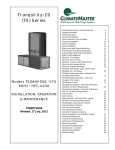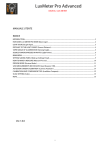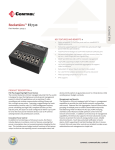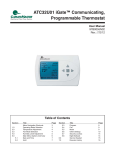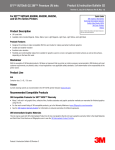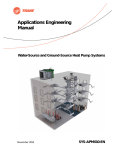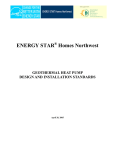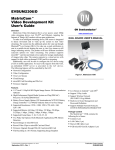Download Page 1 of 2 - ASHRAE® – Pikes Peak
Transcript
November 26, 2010 Mr. Dan Bernstein Thermal Dynamics Inc. 5115 Industrial Street Maple Plain, MN 55359 re: Commercial ground loop design, software tools Dear Dan: Thanks for the call. We hear from many clients and their design engineers frequently concerning the question why eQuest is showing the GSHP option as a poor mechanical choice. The answer is that eQuest is not properly used. To utilize eQuest for a competent comparison requires that the user enter valid parameters into the evaluation from an external design effort, or has sufficient competence/experience to estimate (“WAG”) some reasonable parameters into the evaluation template. eQuest can be used to rough out a loopfield design but only if the user knows what he is doing to begin with. Without some competent input parameters on the loop side (field configuration, pumping power, etc.) the financial analysis will be off. In my experience I have seen more commercial GSHP projects killed across the US because of the improper use of eQuest than installed because of it. For example we are routinely asked to do peer reviews of projects with competing mechanical options using eQuest where the GSHP option is judged to be the worst choice. Reasons include excessive payback, excessively high operating cost, low efficiency estimates of the system, etc. On other projects we have seen the loopfield so undersized had the system gone in as designed it would have been a catastrophic failure. We have converted many of these projects back to GSHP using GLD when we were able to get involved early enough to show solid numbers. eQuest can provide a fair comparison of competing systems, and give a GSHP option it’s just due, if the user understands what he is doing and provides the correct inputs. I believe one key problem with eQuest is that many engineers acquire it at no cost and never learn how to use it correctly; they don’t even realize what they don’t know to make these system evaluations give a fair output. When software costs money people tend to want to learn everything they can from it to extract a better product. The value with a program such as GLD is to perform a detailed loop specification to assist a program such as eQuest to make the correct inputs for a valid operating and life-cycle cost. GLD has another option (finance module) that allows the operator to run a simulation cost that can be compared to eQuest outputs for a crossreference. The GLD operating/life-cycle module has the advantage that it takes the very detailed performance profile of the loop design to account for what the heat pump system is really costing to operate. In my experience the eQuest output is often erroneous (ie, COP under 2.00 when the building is cooling dominant and will obviously provide an EWT on the heating side to easily accommodate a COP exceeding 4.00 or greater even during peak winter conditions) due to the aforementioned lack of experience/training with the user. GLD can also do this for not only vertical ground loops but also horizontal systems and even surface water closed loop designs. Major Geothermal 6285 West 48th Avenue, Wheat Ridge, Colorado 80033 – 303 / 424-1622 voice, 303 / 423-6795 fax Toll free - 800 / 707-9479 www.majorgeothermal.com Page 1 of 2 Here’s the kicker, even the eQuest user’s manual recommends that the operator design the ground loop using other software, such as GHLEPRO, GCHPCalc, GS2000 or GLD. Otherwise the eQuest tool is strictly a trial and error effort – this is where if the user has insufficient experience his ground loop parameter picks are often incompatible with his design and evaluation effort. My comments here are condensed directly from the eQuest user’s manual under “Ground-Source Heat Exchangers Sizing”. See the attached cut-and-paste section from the eQuest manual, last page. Please also note the eQuest narrative warns against using a ‘rule of thumb’ approach – yet that is exactly what we are still seeing on many eQuest evaluations and called a final “design”. Just yesterday I reviewed a system that required 150 boreholes x 300’ resulting from an eQuest output – one for each nominal ton of heat pump capacity – this from an engineering firm paid way more than their calculations or abilities are worth. After a detailed load calculation from our engineer using HAP and using GLD I compressed the field down to 60 holes x 400’ deep – 1st costs dropped as well as the commensurate operating and life cycle costing. And the loop is still conservative to maintain the correct EWT range back to the heat pump system! Anyone doing a detailed operating and life cycle cost analysis where a GSHP option is involved with any tool such as eQuest, Trace 700, HAP, etc., will likely not produce a competent result that gives the GSHP option a fair 1st and operating cost output unless the operator has access and the ability to use a dedicated commercial loop design tool first. GLD has the advantage of running a limited life cycle operating cost estimate that is often more valid and accurate than eQuest for most users in my opinion. GSHP manufacturers, wholesalers and others involved in the industry who assume eQuest is the tool by itself for growing our industry and bottom line are sadly mistaken, and in my opinion are contributing to the delayed growth and acceptance of commercial GSHP installations. We could be moving a lot more boxes and HDPE pipe otherwise. If the industry really wants to grow, it needs to better educate engineers and designers on how to use current offthe-shelf software tools more effectively. IGSHPA’s CGD training program for one needs to be upgraded, and those who manufacture and distribute heat pumps need to understand the design process and limitations/strengths of the software tools available and not merely assume a freeware such as eQuest is the answer by itself to recommend. eQuest can be a strong ally but it needs the support of quality loop design programs, and specific eQuest training schools and more of them. Regards, Terry Terry Proffer, CGD Major Geothermal Geologist IGSHPA Accredited Installer #12131-994 IGSHPA/NATE Certified Installation Instructor #T1063-496 AEE Certified GeoExchange Designer #16 IGSHPA CGD Instructor Colorado Division of Water Resources Closed Loop Certification #GT-13 ClimateMaster Certified Installation Instructor G:\General Correspondence\CommercialGSHPSystems_CommLoopSftwr-vs-eQuest_2010-10-26.docx Major Geothermal 6285 West 48th Avenue, Wheat Ridge, Colorado 80033 – 303 / 424-1622 voice, 303 / 423-6795 fax Toll free - 800 / 707-9479 www.majorgeothermal.com Page 2 of 2 eQuest GSHP Inputs (defaults shown) 1 2 4 3 2 2 2 Ground-Source Heat Pump (GSHP) Equipment Screen This screen is used to indicate design parameters for a ground-source heat pump system including its associated ground loop heat exchanger. This screen is available only if either of the two HVAC System Types is specified as a groundsource heat pump system (i.e., by selecting both Cooling Source and Heating Source as “DX Coils” and HP Source as “Ground Loop” on the General Information screen or HVAC System Definitions screen, then selecting System Type as “Ground-Source Heat Pump”). Ground-source heat pump is a special form of the water-source heat pump application. Different from common watersource heat pump systems that use both cooling tower and boiler to maintain the loop temperature within the specified range, the ground-source heat pump (if not the hybrid type) use only the ground loop heat exchanger to keep the loop temperature within the specified range. The design parameters described on this screen are: ground-source heat pump loop configuration, flow and operation control, and pump size and efficiency, ground loop heat exchanger type, configuration and related inputs, and other related data such as ground and fluid properties, etc. Usage Note: Currently, the eQUEST Wizards support only single central cooling plant models, including single ground-source heat pump plants having only one type of ground loop heat exchanger. DOE-2.2 allows users to model multiple central plants, including multiple ground-source heat pump systems (i.e., plants) and has no limit on the number of ground loop heat exchangers that can be included. Detailed users are referred to the DOE-2.2 Users Manual, Volume 2 (Dictionary) and Volume 3 (Topics) for details on additional DOE-2.2 CIRCULATION-LOOP options available only via eQUEST’s Detailed Interface. Ground-Source HP System - Loop Head GSHP Loop Head is used to specify the TOTAL pressure drop (in feet of head) for the ground source heat pump (GSHP) loop, which contributes to the pumping power (kW) requirements for the GSHP circulation loop as described in the following equation: Example Total GSHP Loop Head = 71.6 ft, GSHP loop flow rate = 200 GPM motor efficiency = 0.85, motor impellor = 0.77 and: Defaults Total GSHP Loop Head = Max [condenser coil pressure drop, def = 20ft] of all GSHP condenser coils on the loop+ ground heat exchanger field (def = 30ft) + GSHP pipe friction and fittings pressure drop (21.6ft) + Static head, def = 0 Where: the default pressure loss due to pipe and fittings friction assumes an average circulation time of 1.5 minutes × 14.4 ft/min. The factor 14.4 ft/min is based on: an average (above ground) condenser pipe size of 2 in, 4 ft/sec average fluid velocity, and a head loss of 3 ft/100 ft, doubled for fittings. Range The minimum allowed value for GSHP Loop Head is the sum of the DOE-2 default pressure drop for the components attached to the GSHP loop, e.g., 20ft for the DX condensers (assumed to be plumbed in parallel) + the pressure drop associated with the ground heat exchanger (defaults to 30ft in the wizard and in DOE-2 but is available in the wizard… see GHX Pipe Head). See ‘DOE-2 Notes’ below. Important As the GSHP Loop Head will help determine the pumping power requirements, when making comparisons between aircooled and GSHP HVAC systems, the GSHP Loop Head should be specified carefully. DOE-2 Notes: SYSTEM CW-COIL-HEAD (default = 20ft) is not written to the DOE-2 INP file by the wizard (i.e., it is allowed to default). GSHP CIRCULATION-LOOP PIPE-HEAD is written as follows: GSHP CIRCULATION-LOOP PIPE-HEAD = Total GSHP Loop Head – 20ft (condenser coil pressure drop) – ground heat exchanger pressure drop (def = 30ft) – 0ft (static head) Ground-Source HP System - Loop Design Delta T GSHP Loop Design Delta T is principally used, along with GSHP peak load (OR installed heat rejection capacity) to solve for the GSHP loop flow rate (GPM). GSHP Loop Design Delta T is also used to help size the GSHP pumps (see GSHP Loop Head) which determines the pumping power (kW) requirements for the GSHP circulation loop. Defaults GSHP Loop Design Delta T = 10F Important As the GSHP Loop Design Delta T will help determine the GSHP flow and pumping power requirements, the GSHP Loop Design Delta T should be specified carefully. DOE-2 Notes: Input for GSHP Loop Design Delta T is written directly to GSHP CIRCULATION-LOOP LOOP-DESIGN-DT. Ground-Source HP System - Pump Configuration GSHP System Pump Configuration is used to indicate the location of pumps on the ground-source heat pump system. There is currently only one choice: "Single Loop Pump(s) Only" The GSHP loop pumps are located only at the loop level and are used to overcome all pressure drops associated with the entire system (ground loop heat exchanger, coils, piping, etc.). Ground-Source HP System - Loop Flow GSHP System Loop Flow is used to indicate whether the flow in the GSHP loop is constant or can be modulated. There are two choices: "Constant" "Variable" This indicates that whenever the pumps are running, loop flow will remain constant. This implies threeway valves throughout the system. This is the default GSHP System Loop Flow. This indicates that whenever the pumps are running, loop flow will modulate to meet load requirements. This implies two-way valves throughout the system. Pump Control is specified separately. Ground-Source HP System - Operation GSHP System Control Operation is used to indicate the method of operation control for the ground-source heat pump system. There are two choices: "Standby" Causes the loop to be active (i.e., pumps on) whenever any one of the systems served by the loop is running (i.e., fans on). Note that, in this mode, even if all of the thermostats in all of the zones served by the loop are satisfied (i.e., no load), the loop will be active (i.e., pumps running). "Demand" Causes the loop to be active only when a coil load (i.e., thermostat demand) actually exists. This is the most energy-efficient mode of operation. For example, if an attached system is running, the GSHP loop will not activate until there is actually a cooling or heating load. "Sub-Hour Demand" Specifies that the loop pump will cycle during the hour as required to meet loop flows that are less than design. This allows for better performance calculation when one or a few DX units are attached to a loop, and the loop pump cycles off whenever the unit(s) is not operating. In this situation, the program calculates the flow using the actual flow passed through the DX units when operating, adjusted by a diversity factor that takes into account the fact that the operation of various units on the loop do not necessarily coincide. Warning: The temperature existing a ground-loop heat exchanger will be affected by the cycling period (for a given hourly load, as the load is compressed into a smaller faction of the hour, the rate at which heat is extracted from or rejected to the ground increase, thereby affecting the temperature.) Ground-Source HP System - Min/Max Loop Temperatures GSHP Loop Min/Max Temperatures are used to indicate the acceptable range of loop operating temperatures for the ground-source heat pump system. DOE-2 Note: The HEAT-SETPT-T and COOL-SETPT-T keywords are unused if GSHP is specified. Ground-Source HP System - Number of Loop Pumps Number of GSHP System Pumps is used to indicate the number of identical pumps attached directly to the GSHP loop. Usage Note: Multiple pumps will stage as required by the current loop flow and head; however, if no means of flow modulation is provided (e.g., GSHP Loop Flow = Variable), then only one pump will run. DOE-2 Note: Currently, pump head set point control and sensor location inputs are not specified in eQUEST’s wizards. For GSHP Loop Flow = Constant OR Variable, pump head set point control is assumed to be fixed and the differential pressure sensor location is assumed to be at the beginning of the loop (downstream of any primary equipment). Other options are available in DOE-2.2 using CIRCULATION-LOOP / HEAD-SETPT-CTRL and HEAD-SENSORLOCN. Detailed users are referred to the DOE-2.2 Users Manual, Volume 2 (Dictionary) and Volume 3 (Topics) for details on these and other DOE-2.2 CIRCULATION-LOOP options available only via eQUEST’s Detailed Interface. Ground-Source HP System Pump(s) - Head GSHP System Pump Head is used to specify the design pressure rise across the loop pump when the pump is running. Important: This input affects the sizing of the pump ONLY. It does not determine the total pressure rise across the entire GSHP loop. To specify the total GSHP loop head, see GSHP Loop Head on this same screen. Default: No default value is diplayed for GSHP System Pump Head. The DOE-2 default is 20% larger than GSHP Loop Head on this same screen. Usage Note: If you wish to have DOE-2 estimate the GSHP System Pump Head, leave GSHP System Pump Head blank. Pump head can vary widely and can be difficult to estimate, therefore, when pump energy is important to simulate accurately, users are encouraged to provide their own estimate based on the design plans (see GSHP Loop Head on this same screen).. Ground-Source HP System Pump(s) - Flow GSHP Loop Pump Flow is used to specify the design flow of the GSHP loop pump. Important: This input affects the sizing of the pump ONLY. It does not determine the total flow rate for the entire loop. Total flow rate for the entire loop is NOT a user input. Rather, total flow rate for the entire loop is solved for during the simulation based on loop design delta T (see loop design DT on this screen) AND either 1) total system load (based on the simulated load on all coils on the loop), OR 2) user input primary equipment capacity. Default: The total flow rate for the entire loop is solved for during the simulation, based on loop design delta T (see loop design DT on this screen) and total system load (based on the simulated load on all coils on the loop). Usage Note: If you wish to have DOE-2 estimate the GSHP Loop Pump Flow, leave GSHP Loop Pump Flow blank. The DOE-2 default for pump flow is based on DOE-2’s design sizing routines. Detailed users are referred to the DOE-2.2 Users Manual, Volume 2 (Dictionary) and Volume 3 (Topics) for details on CIRCULATION-LOOP SIZING-OPTION available only via eQUEST’s Detailed Interface. Ground-Source HP System Pump(s) - Motor Efficiency GSHP Loop Pump Motor Efficiency is used to indicate the motor class for the Pump Motor. There are three choices: "Standard" A standard efficiency motor. Note that this would only be found in an older, existing central plant. "High" A NEMA high-efficiency motor. “Premium” A NEMA premium-efficiency motor. See the table of default pump motor efficiencies, based on motor class and motor size (hp). Ground-Source HP System Pump(s) - Control GSHP Loop Pump Control is available only if GSHP Loop Flow = Variable and is used to indicate how the loop pump modulates as the flow varies. There are three choices: "Single Speed" The pump rides its curve as the flow varies. This is the default GSHP Loop Pump Control. "Two Speed" The pump can operate at two speeds. “VSD” The pump has a variable frequency drive. DOE-2 Note: For GSHP Loop Pump Control = "Two Speed" the low-speed is determined by the DOE-2 PUMP keyword, “MIN-SPEED”, which defaults to 0.67. “VSD” the minimum pump speed is determined by the DOE-2 PUMP keyword, MIN-SPEED. Note that a pump’s speed is not usually proportional to flow; speed is a function of both the pump flow as well as the pump head requirement. If the pump head requirement does not fall off as the square of flow (for example, when the pump has a fixed head setpoint), then the pump will operate at a speed higher than it would otherwise Detailed users are referred to the DOE-2.2 Users Manual, Volume 2 (Dictionary) and Volume 3 (Topics) for details on DOE-2.2 PUMP options available only via eQUEST’s Detailed Interface. GSHP Ground Temperature - Specification Type The Ground Temperature Specification Type is a selection that determines whether the mean undisturbed ground temperature is to be calculated by DOE-2 or entered by the user. The two available selections are: "Calculate via Weather Data" "Specify" The mean undisturbed ground temperature is set to the average annual air temperature plus the adjustment factor provided when this option is selected. This is the default Ground Temperature Specification Type. Indicates that the user will specify the mean undisturbed ground temperature. GSHP Ground Temperature - Adjustment Factor The Ground Temperature Adjustment Factor field is available only if the user has chooses “Calculate via Weather Data” for the Ground Temperature Specification Type. The sum of this adjustment factor and the average annual air temperature computed by the simulation is used to represent the mean undisturbed ground temperature. GSHP Soil Thermal Properties - Ground Description Ground Description and related thermal properties are important parameters of the ground formation at the site where ground loop heat exchanger (GLHE) is installed. By selecting the rock or soil type that most closely represents the ground formation of the site, the thermal conductivity and diffusivity of the ground are specified. The table of ground thermal properties lists the name of various kinds of rock/soil and the associated values of thermal conductivity and diffusivity. Since the thermal properties for some types of rock/soil may vary significantly at different locations, the minimum and maximum values of the thermal properties (when applicable) are also given in the table along with the recommend values, which are used as program defaults. Usage Notes: The thermal properties of rock/soil can vary widely and will significantly affect the performance of a GSHP system. Therefore, users are encouraged to obtain more accurate estimation of the ground thermal properties from other resources, such as local geological surveys, lab tests, and in-situ measurement of the ground thermal properties. Users can either select a rock/soil type from the list (in which case the thermal conductivity and diffusivity from the table of ground thermal properties for the selected rock/soil are used) or input the ground thermal conductivity and diffusivity by selecting “- specify -” from the Ground Description list. GSHP Soil Thermal Properties - Grout Description Grouting of the entire vertical bore is often required to prevent surface water penetration and potential groundwater contamination and also serves to provide better thermal contact between the pipe and the ground. The thermal conductivity of the grout (backfill) material significantly affects the heat transfer performance of the vertical GLHE. The thermal conductivity of typical grouts and backfills used in the vertical GLHE are listed in grout thermal properties table. Since the thermal storage effects of the grout material are negligible, the thermal diffusivity of grout material is not required for the simulation of vertical GLHE. It is recommended to use thermally enhanced grouts in vertical GLHE as opposed to conventional high-solids (bentonite) grouts. Usage Note: Users can either select a grout or backfill material from the list (in which case the thermal conductivity from the table of grout thermal properties for the selected grout or backfill is used) or input the grout thermal conductivity by selecting “specify -” from the Grout Description list. Ground Loop Heat Exchanger – Type There is currently only one option available to describe the Ground Loop Heat Exchanger Type: "Vertical Well Field" The Vertical Well Field is the pre-dominant GLHX type used in commercial and institutional applications. This type of heat exchanger has one or more vertical closed loop ground heat exchanger(s), which consist of a borehole of diameter 3-6 inch into which is inserted a loop of pipe with a ‘U’ bend at the bottom. The borehole is then either back-filled or, more commonly, grouted over its full depth. The pipe used in these systems is typically High Density Polyethylene (HDPE) of nominal diameter in the range 3/4 inch - 2 inch. The depth of the borehole varies between typically 100 ft and 400 ft. Usage Note: DOE-2 also supports additional Ground Loop Heat Exchanger Type options. Detailed users are referred to the DOE-2.2 Users Manual, Volume 2 (Dictionary) for details on DOE-2.2 Ground Loop Heat Exchanger Type (see “GROUNDLOOP-HX”) available only via eQUEST’s Detailed Interface. Ground Loop Heat Exchanger - Configuration Ground Loop Heat Exchanger Configuration options vary based on the selected Ground Loop Heat Exchanger Type. There are currently 7 geometries of Vertical Well Field that can be selected, each of which are described in the GLHX Vertical Well Field Configuration Table. IMPORTANT Note: Ground source heat exchangers (e.g., ground well fields) are among the few HVAC equipment components that eQUEST is currently UNABLE to AUTOMATICALLY size based on design day or annual hourly simulation and NO default sizing is provided in eQUEST’s wizard for ground source heat exchange components. For more information regarding sizing of ground well fields, see the IMPORTANT NOTE at the symbol adjacent to this Configuration input on this same screen. Usage Note: The Vertical Well Field model implemented in DOE 2.2 uses g-functions developed by Lund University, Sweden. There are unique g-functions for each configuration of Vertical Well Field. Climatemaster Inc. (www.ClimateMaster.com) can be contacted in order to gain access to g-functions of vertical well field configurations other than those provided in the default eQUEST implementation. Climatemaster also conducts training events on how to use eQUEST to size vertical close loop ground heat exchanger and perform energy analysis for ground source (geothermal) heat pump systems. Ground Loop Heat Exchanger - Number of Identical Well Fields IMPORTANT Note: Ground source heat exchangers (e.g., ground well fields) are among the few HVAC equipment components that eQUEST is currently UNABLE to AUTOMATICALLY size based on design day or annual hourly simulation and NO default sizing is provided in eQUEST’s wizard for ground source heat exchange components. For more information regarding sizing of ground well fields, see the IMPORTANT NOTE at the symbol adjacent to the Configuration input on this same screen. Usage Note: DOE-2 assumes that the identical well fields do not interact with each other. This assumption is only valid when the identical well fields are apart from each other with enough distance. For large vertical well field with many boreholes placed closely, it is recommended to use the corresponding g-functions to simulate the vertical well field more accurately Climatemaster Inc. (www.ClimateMaster.com) can be contacted in order to gain access to g-functions of vertical well field configurations other than those provided in the default eQUEST implementation. Climatemaster also conducts training events on how to use eQUEST to size vertical close loop ground heat exchanger and perform energy analysis for ground source (geothermal) heat pump systems. Ground Loop Heat Exchanger - Depth IMPORTANT Note: Ground source heat exchangers (e.g., ground well fields) are among the few HVAC equipment components that eQUEST is currently UNABLE to AUTOMATICALLY size based on design day or annual hourly simulation and NO default sizing is provided in eQUEST’s wizard for ground source heat exchange components. For more information regarding sizing of ground well fields, see the IMPORTANT NOTE at the symbol adjacent to the Configuration input on this same screen. The meaning and use of Ground Loop Heat Exchanger Depth varies based on GLHX type as follows: For Vertical Well Fields, the GLHX Depth is the distance between the ground surface and the bottom of each well. For Horizontal Loops (either straight or slinky), the GLHX Depth is the distance between the ground surface and the bottom of the trench. Usage Note: Due to the huge thermal storage effects of the ground, it is strongly recommended that the user examine the long-term performance of a GSHP system. This is particularly important when the annual cooling and heating loads are not balanced. Specify the Years of Previous Operation to properly account for previous years of operation. Ground Loop Heat Exchanger - Spacing IMPORTANT Note: Ground source heat exchangers (e.g., ground well fields) are among the few HVAC equipment components that eQUEST is currently UNABLE to AUTOMATICALLY size based on design day or annual hourly simulation and NO default sizing is provided in eQUEST’s wizard for ground source heat exchange components. For more information regarding sizing of ground well fields, see the IMPORTANT NOTE at the symbol adjacent to the Configuration input on this same screen. The meaning and use of Ground Loop Heat Exchanger Spacing varies based on GLHX type as follows: For Vertical Well Fields, the GLHX Depth is the distance between the centerline of each well. For Horizontal Loops (either straight or slinky), the GLHX Depth is the distance between the centerlines of each trench. Usage Note: To account for the heat build up in the well field after long-term operation of the GSHP system, a minimum spacing of 20 ft is recommended (ASHRAE handbook – HVAC Applications – 2007, pg. 32.10) whenever wells are placed in a grid pattern (i.e. in the form of a rectangular field). This distance may be reduced when the wells are placed in a single row (or other geometries less dense as the rectangular field), the annual heating load is much greater than the annual cooling load, or ground water movement mitigates the affect of the heat build up in the well field. Ground Loop Heat Exchanger - Pipe Size GLHX Pipe Size is the nominal size of a U-tube, which is directly related to the outside diameter of the tube. However, the inside diameter and thickness of the pipe wall also impacts the system’s performance and depends on the specified pressure rating of the U-tube. There are two pressure rating systems for pipes: one is the Schedule dimension, and the other is the Standard Dimension Ratio (SDR). The inside diameter and thickness of the pipe wall for various sizes of pipes with different pressure ratings are provided in the GLHX pipe size & rating table. Usage Note: Outside & inside diameters from the GLHX pipe size & rating table are used if the user chooses from the pre-defined options for GLHX Pipe Size & Rating. If the user chooses “- specify -” for either the GLHX Pipe Size or Rating inputs, then they have the ability to specify both the outside and inside pipe diameters. Ground Loop Heat Exchanger - Pipe Head The GLHX Pipe Head is used to specify the pressure drop associated with the ground loop heat exchanger. It is included in the pressure drop components summed to estimate the total GSHP Loop Head (see GSHP Loop Head). Defaults: Caution: GLHX Pipe Head always defaults to 30 ft of head. Important: As the GLHX Pipe Head will be an important determinant of the ground source system pumping power requirements, when making comparisons GSHP HVAC systems and alternative HVAC systems, the GLHX Pipe Head should be specified carefully. See design plans where possible. Ground-Source Heat Exchangers Sizing IMPORTANT NOTE regarding ground source heat exchanger sizing in eQUEST: Ground source heat exchangers (e.g., ground well fields) are among the few HVAC equipment components that eQUEST is currently UNABLE to AUTOMATICALLY size based on design day or annual hourly simulation and NO default sizing is provided in eQUEST’s wizard for ground source heat exchange components. Sizing for ground source heat exchange components based on user rules of thumb alone is not recommended for design purposes, though it could provide a starting point in the simulation‐based trial‐and‐error strategy described below. Users can size the well field or other ground source heat exchange components with either dedicated design programs, other recognized design methods, or eQUEST itself. Examples of dedicated ground source heat exchange components sizing programs include: GCHPCalc, GS2000, GLHEPRO, and GLD (Ground Loop Design). Web searching for these products should easily locate additional information about each. See also ASHRAE’s “Ground Source Heat Pumps: Design of Geothermal Systems for Commercial and Institutional Buildings” (www.ashrae.org). eQUEST can also be used to size ground source heat exchange components via an iterative ‘manual’ trial‐and‐error annual simulation process. In this case, users can start with an initial design of the ground heat exchanger determined from rules of thumb (e.g., 200 ft deep vertical bore for each cooling ton capacity) then run the simulation and examine whether the simulated ground well field design yields acceptable hourly and annual performance, i.e., acceptable maximum leaving fluid temperatures over a selected time period (i.e. 20 years). In eQUEST’s detailed results file, the SIM file, see for example the PS‐D and PS‐H reports. Also, hourly reports for the well field may be helpful. (To see how to specify hourly reports in eQUEST’s Detailed Interface, see the eQUEST Modeling Procedures Quick Reference Guide, available at any eQUEST input field via a right mouse click). If the initial design of a ground heat exchanger does not yield acceptable performance, the user can adjust model inputs, such as bore depth, bore spacing, bore field configurations, grout material, etc., and re‐run the revised simulation and re‐examine the resulting performance. Using eQUEST in this method will usually require several iterations to get a satisfactory design for the ground heat exchanger. Climatemaster Inc. (www.ClimateMaster.com) can be contacted to gain access to g functions of vertical well field configurations other than those provided in the default eQUEST implementation. Climatemaster also conducts training events on how to use eQUEST to size vertical close loop ground heat exchanger and perform energy analysis for ground source (geothermal) heat pump systems.











